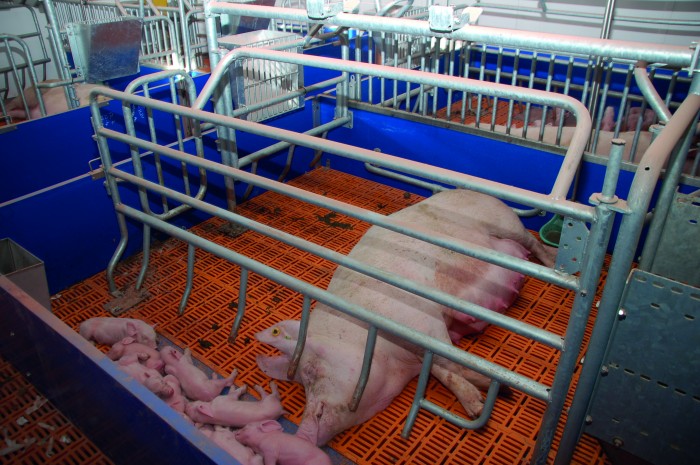The continuing focus on the future of farrowing crates has inevitably prompted increased in free farrowing systems. Here, ARM outlines some positive feedback from farmers who have already made the transition.
Ever since the British pig industry became badly caught-out by the unilateral banning of sow stalls in 1999, great attention has been paid to welfare. Richard Body’s Bill was seen as a major factor in the virtual halving in the size of a national sow herd.
Supermarkets were keen to show the ‘ethical’ origins of British pigmeat (while shamelessly buying cheap pork from the continent) accelerating the trend to outdoor farrowing, which now accounts for over 40% of the herd.
It’s not surprising that the substantial indoor sector is wary about the future and this, together with the threat of further legislation on farrowing crates, has contributed to increasing interest in ‘freedom’ farrowing systems.
Pig housing specialist, ARM buildings, has reported a surge of orders for these free-style farrowing pens and expects to have completed well over a thousand installations later this year. The company has installed four different systems, all of which have been developed on the continent, where most sows are farrowed in intensive systems, perhaps creating a greater need for more welfare-friendly systems.
The influential German market is a big driver of that development. Expectations are that legislation will require all sows in that country to be offered free farrowing systems by 2035. Although the exact requirements are not yet known, it is anticipated that the total pen area will be 6.5 sq m with the unconfined sows having access to 4.5 sq m of space and will be allowed to be confined within a crate for five days. This seems to be broadly what manufacturers are working to.
ARM, which has recently taken on the Nijenkamp free farrowing system, has been investigating farmers’ experiences with the systems that it has already supplied and also the performance from them. Most freedom farrowing pens have been installed in brand new houses so the company is keen to point out that a direct comparison cannot fairly be made between performance in the old and new systems.
Last year, Pig World, reported on northern farmer, Bill Bacon (who does not want his name published, as he is wary of animal rights activists, despite, ironically, investing thousands of pounds on housing to improve the welfare of his pigs). ARM supplied him with new buildings containing 80 farrowing pens with the Big Dutchman freedom-style layout.
Since the pens were installed there have been 691 farrowings, with an average of 14.85 pigs born alive and 13.11 reared. This compared with 565 farrowings under the old, conventional crate system with 14.38 born alive and 11.63 reared. Interestingly, average piglet weaning weight has increased from 7.8 kg to 8.1 kg while total litter weight improved from 90.71kg to 106 kg.
“In general, we are very pleased with the system although there are still plenty of things that can be improved upon. Pre-weaning mortality has come down from 18% in the old buildings to 11.6%, but we feel this could be reduced still further,” said Bill.
Sows are a lot calmer and their feed intake is up leading to the higher weaning weights. The ability to shut the sow in makes vaccinating the piglets very easy.
“The particular crate design meant that there is reduced space for the creep feeder, but after testing different types we have found one that suits the pen,” he said.
Would Bill recommend the system to other pig farmers? “Yes, and if you asked my pigman, who had 40 plus years’ experience, if he wanted to go back to conventional crates, his response would be ‘no’.”
Tim Miller, ARM’s environmental specialist, has visited most of the large freedom-style systems operating in the UK and ease of management has been the predominant feedback. The lack of stress when getting sows in and out of the pens and the restraint of the sow during routine treatment of piglets has been noted.
All systems have a 6.0 sq m ‘footprint’, but the open area for the sow varies from under 3,0 sq m to 4.2 sq m according to the crate design and pen configuration.
If time allows, farmers put their sows in the pens around five days before farrowing, with the crate open, so she has the freedom of the pen, although most put the sow straight into the crate as they farrow soon after. At farrowing they are only enclosed for three or four days before being released. Most of the systems provide ad lib feeding for the sows from farrowing.
One large scale unit with 200 freedom pens in northern England is achieving a remarkable 6-8% mortality from 14.7 piglets born alive and is now installing a further 200 pens.
“So far, very few downsides have been reported – but the main one is, obviously, expense. Construction costs per sow increase if fewer sows are put into a house of a given size and this can amount to an extra 40-50%”, said Mr Miller.
“Depending on the design, the equipment and ventilation system, size of room, costs can vary and normally start at around £4,500 per sow place. But this must be set against improved performance, more contented sows, and happier staff, apart from future-proofing a unit against probable future legislation and consumer reaction.”




